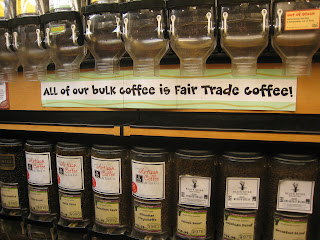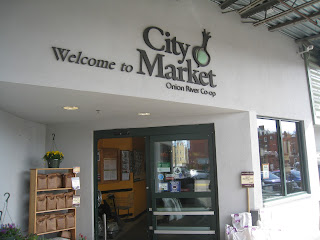 |
| Local Apples From Vermont |
 |
 |
| There is no guessing as to where your produce comes from. |
 | |
| Organic and Fair Trade |
 |
| It is also easy to find bulk foods from local sources |
 |
| Even beans |
 |
| And Spices (Organic Ground Nutmeg) |
 |
| Signage around the market lets customers know when their local food was made. |
Map of City Market
Done by: Emily Lopuski
Where can you find local and organic foods? Everywhere.
City market takes great pride in "providing conventional, organic and local products at a fair price to all. The Co-op is dedicated to supporting the local economy and strengthening the local food system. We work with thousands of Vermont vendors to feature a wide selection of local and Vermont-made products."
City market takes great pride in "providing conventional, organic and local products at a fair price to all. The Co-op is dedicated to supporting the local economy and strengthening the local food system. We work with thousands of Vermont vendors to feature a wide selection of local and Vermont-made products."
Interested in only buying local? You're in luck!
City Market provides you with a brochure which has every local product laid out for you.
Interested in learning more?
City Market's website does a great job at telling you about well, everything they're about!
Let me read on!
Interview with Meg Klepack, local foods coordinator at City Market
Peter BoyerApril 18
Last week I interviewed Meg Klepack, the local foods coordinator at City
Market/Onion River Co-op, to have a closer look at the market's role in the
local food system. Behind my questioning, I am wondering, "how does the
market contribute to the social, economic, and environmental wellbeing of the
local and regional community, and what indicators are used to describe this
wellbeing?"
The interview was casual and informal; it was rather more like an
open-ended discussion. I have organized the jumble of content into nests of
interesting information, to be brooded over with insulating hopes of hatching
new insights and understandings of the meanings of sustainable food systems.
First, a simple overview of the cooperative model of City Market: 7,000
members comprise the cooperative, and 175 employees are staffed there. Being a
cooperative, the market is not driven by the single goal of profit- it is
motivated by certain values, shared with and largely dictated by its members,
consumers, and the community, to work towards the goals of its mission
statement (can be found on the market's website):
"The
Onion River Co-op will be central to a thriving and healthy community, where:
Consumers
have local access to progressive social, environmental and healthful choices;
Residents enjoy an enhanced quality of life; The local food system is strengthened; The cooperative model is
supported; and our owners have a sense of pride in their cooperative."
The market has been tracking the number of local products offered, and
the amount of sales. There are over 2,000 local products available at City
Market. Thirty percent of sales at the market are of products which are local
or Made in Vermont.
In comparison, the state average for these sales is 5%, across the board.
-What
is "local" anyway? -------->Local is defined as produced within
the state of Vermont.
-What
is "Made in Vermont"?
------> This refers to a product whose constituent ingredients may not
originate locally but are "substantially transformed" in the state of Vermont.
Meg made the point that the push for local food came from individuals
and grassroots organizations- "locavores". In this sense, the
movement has been consumer-driven. Consumers want more transparency of where
their food comes from, and markets are responding to this demand. I'll get back
to transparency, momentarily.
[I had wondered, how much
of what the market offers (concerning their "progressive social,
environmental and healthful choices") is driven by consumer demand, and how much of consumer demand for
these products is driven/reinforced by the market itself?
-Meg
articulated that the market mostly follows and responds to consumer demand. As,
for example, demand for gluten free products has surfaced (especially in the
last year or so) the market has responded by offering more of these products.
In selecting products to meet consumer demand, as Meg addressed it, the market
makes an effort to offer a diversity of products so that consumers have the
freedom to choose for themselves. That sounds like a sound marketing strategy
to me, but I am still wondering about the initial question... There must be, to
some degree, a reciprocal interaction of demand between market outlet and
consumer base. Anyway.]
Both demand and supply have increased dramatically in quite a short time
frame (the position of local foods coordinator that Meg holds didn't even exist
3 years ago). As the local food system stands today, from the eyes of City
Market, there is more demand for local foods than there is supply, in many
areas. City Market would certainly purchase more local food if it was more
available or accessible. City Market is constantly looking for more local
products to sell in the market.
Because of the abundance of demand from City Market consumers, another
store is planned to open sometime in the future...
The market is also aware of gaps in the distribution of local food from
producer to consumer, and searches for possible outlets to fill these gaps.
Example: frozen, local produce. To fill this gap, City Market worked in
partnership with other cooperatives to initiate production of frozen veggies.
[Cooperation among cooperatives... sounds like a community interaction that
reinforces social wellbeing!] Other gaps exist in the availability of certain
crops, their quantities, seasonality, and price conversations.
In some cases, local farms are on a scale that is too small to reach a
larger market outlet such as grocery stores, schools, and hospitals. Efforts
are being made to figure out how to connect small farms (of which the local
food system is largely composed of) to these larger market outlets. One method
is to aggregate the products of small farm operations into food hubs which can
then distribute to larger markets. However, this creates more distance between
the producer and consumer, thus decreasing transparency...
Transparency is an important quality in the local food system, and is a
primary value of local food consumers. It becomes considerably more difficult,
nearing the point of impossibility, to trace the origin of food products as
they are further aggregated, processed, transported, and sold through the many
levels of the greater, conventional food system. Localism has largely been
driven by this disconnect of producer to consumer in the food system. As a
general quality, the less distance there is between the origin of your food and
your dinner plate, the higher the transparency. Increasingly, consumers want to
know where their food comes from, how it was produced, and how it got to the
store shelf. It is part of Meg's job to gather all sorts of information on the
producers of the local food sold at the market, to be made available to
consumers.
Alongside a healthy food system is a healthy social system. City Market
has its ways of strengthening the social system it is a part of, which may be
quite different than other, more traditional market outlets. Being a
cooperative, it is member owned and governed. Members elect the folks upstairs
who ultimately call the shots. Members also decide what to do with and share
yearly profits. As a member, you can also work in the various departments of
the store or in certain community projects for monthly discounts on food.
Members, as well as the general community, are also offered various classes (6
- 8 per month) related to food and holistic health organized by the market.
This all represents a significant level of interaction between the market and
its consumers. I'll attest, as a City Market member and consumer, to the
positive sense of belonging that comes with this interaction.
City Market is known to have high prices. I've wondered to what degree
this deters low-income community members. Its hard to say, but City Market does
support Food Stamps (Three Squares VT), WIC, and disability assistance. Also,
their Food for All Program gives a 10% discount on all food products if you are
a participant of any of these government assistance programs. Food is donated
to the Chittenden Emergency Food Shelf as well. That's an encouragement.
Besides healthy interaction at the individual level, City Market also
makes connections with other community organizations. They organize "crop
mobs" where cooperative member-workers visit a local farm and give a hand
in whatever work needs done. Meg likened this to community barn-raisings of the
past (excluding Holmes county OH and Lancaster county PA!).
Meg mentioned that loans are also given to other cooperative organizations in
need. I see this, too, as a significant quality of social wellbeing and a step
in the direction of sustainability!
Overall, this is surely just a glimpse at the complexity of the local
food system and how it relates to social, economic, and environmental wellbeing
for now and for future generations- i.e. sustainability!















No comments:
Post a Comment